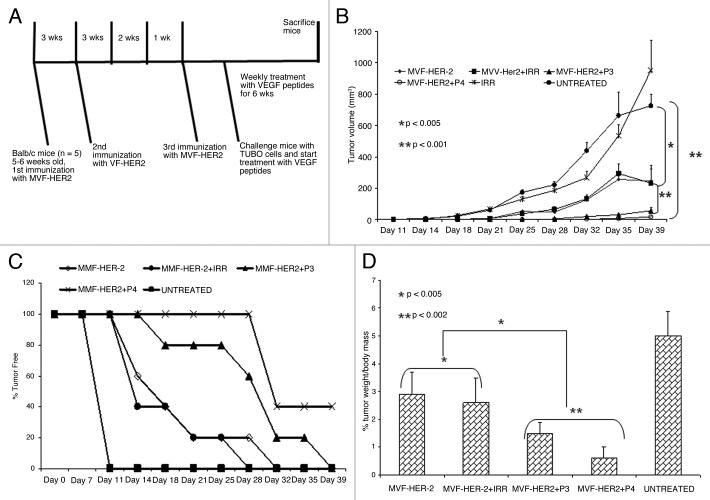Figure 5. Effects of HER-2 Immunization and VEGF peptide treatment in a transplantable tumor model. (A) Immunization scheme for BALB/c mice. Mice were immunized subcutaneously with 100 μg of MVF-HER-2 three times at three weeks intervals. Two weeks after the third immunization, mice were challenged with TUBO cells and treated weekly with VEGF peptide mimics and irrelevant peptide for 6 weeks. (B) Effects of combination treatment on tumor growth. Wild type BALB/c mice (n = 5), at the age of 5–7 weeks were immunized subcutaneously three times at three weeks intervals with 100 μg of MVF-HER-2 emulsified in ISA720. After immunization, mice were challenged with TUBO cells and treated intravenously with VEGF peptide mimics or an irrelevant peptide. Tumor measurements were performed twice a week using calipers. The data are presented as the average tumor volume per group and are reported as mm3. Results show a statistical significant difference between the group immunized with MVF-HER-2 vs. the group treated with the VEGF peptide mimics (**p < 0.001). There was a significant difference between immunization plus irrelevant peptide vs. immunization plus treatment with VEGF peptide mimics (*p < 0.001). (C) Effects of immunization and treatment on tumor-free survival rates. Results show that immunization with MVF-HER-2 and treatment with VEGF-P4 produced the best results since 40% of the mice (2 out of 5) remained tumor-free at the end of the experiment. There was also a greater delay in onset of tumor development in the case of VEGF-P3 peptide as compared with the MVF-HER-2 immunization alone. (D) Effects of peptide treatment on % tumor weight per body mass. After treatment, tumors were removed and weighed and the results show a significant difference between treated and untreated groups. p values are reported.

An official website of the United States government
Here's how you know
Official websites use .gov
A
.gov website belongs to an official
government organization in the United States.
Secure .gov websites use HTTPS
A lock (
) or https:// means you've safely
connected to the .gov website. Share sensitive
information only on official, secure websites.
